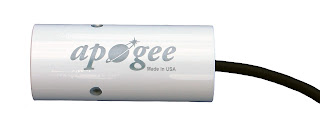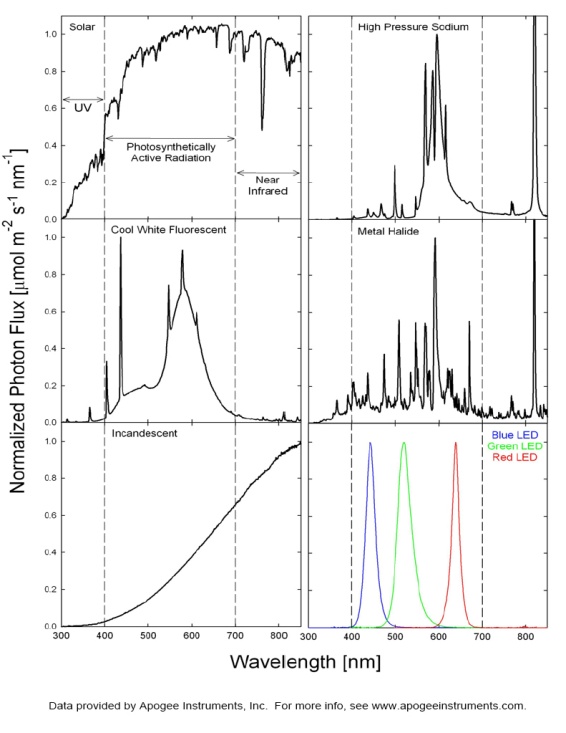
Temperature of an object is determined by three modes of heat transfer: conduction, convection, and radiation. While conduction and convection are generally easier to understand, radiation is often the most important mode of heat transfer. Understanding the underlying principles of radiation heat transfer helps to accurately measure surface temperatures at a distance with Apogee’s
Infrared Radiometers (IRR). In this post I outline the essential principles in order to help you make better measurements.
Blackbody Radiation
All objects above 0 K (-273.15°C) emit radiation at the surface, due to the internal energy contained within the object. Radiation is continuously being emitted from surfaces and being absorbed, transmitted, and reflected. Some surfaces emit or absorb, for instance, better than others. This is mainly due to a surface condition called emissivity, which is determined by color, finish, and intrinsic material properties. Emissivity is a ratio of how well a surface performs as an emitter of infrared radiation in comparison to what is commonly called a blackbody, or ideal radiator. A blackbody is described as follows:
- A blackbody absorbs all incident radiation, regardless of wavelength and direction.
- For a prescribed temperature and wavelength, no surface can emit more energy than a blackbody.
- Although the radiation emitted by a blackbody is a function of wavelength and temperature, it is independent of direction. That is, the blackbody is a diffuse emitter [1].
Generally speaking, a blackbody is the perfect absorber and emitter. It is the standard we compare other radiating surfaces against. No other surface absorbs more energy or emits it than a blackbody. In addition, no radiation emitted from a blackbody is reflected from other sources.
According to the Stefan-Boltzmann Law, the emissive power of a blackbody is E
b=σT
4, where

and the temperature is measured in Kelvin. Accordingly, for a non-blackbody, the emissive power is E
b=εσT
4, where ε is the emissivity of the surface being considered (0<ε<1), and ε = 1 for a blackbody. The chart below shows emissivities for common materials. Additional values can be found at its source:
http://www.engineeringtoolbox.com/emissivity-coefficients-d_447.html.
Although emissivities are not constant over all wavelengths, it is generally accepted practice to assume them constant due to the small amount of variation over the different wavelengths for most materials.
For plant scientists, it might also be interesting to consider the emissivities documented for various plant leaves and diverse vegetation over different wavelengths (
http://g.icess.ucsb.edu/modis/EMIS/html/leaf.html).
Emissivity Correction
If emissivity isn’t taken into account, the surface temperature of an object may appear to be emitting more radiation, due to the addition of reflective radiation for instance, than it really is and thereby giving us an incorrect perception for the emissive power or temperature of that surface. This can be especially true for an IRR sensor that has been calibrated to a nearly standard blackbody surface. The calibration procedure for Apogee’s IRR sensors (
http://www.apogeeinstruments.com/content/SI-calibrationposter.pdf ) shows just that.
The question then is: how can I adapt for such a situation?
Appropriate correction for target emissivity is required for accurate surface temperature measurements. However, the simple correction that is commonly made, dividing the measured temperature by the target emissivity, is incorrect because it does not account for reflected radiation. The radiation detected by an infrared radiometer includes two components: 1) the radiation directly emitted by the target surface, and 2) reflected radiation from the background. The second component is often neglected. The ratio of the two components in the radiation detected by the radiometer is weighted according to the emissivity (ε) of the target surface:
Which after substitution of the Stefan-Boltzmann Law and rearranging, we get:
In order to apply the above equation however, we must measure or estimate with reasonable accuracy the brightness temperature of the background (
Tbackground). For a more in-depth explanation of how to do so, please see:
http://www.apogeeinstruments.com/content/SI-emissivitycorrection.pdf.
In any case, as the emissivity of what we are trying to measure moves further away from a blackbody, the more that emissivity error is introduced due to reflected radiation from surroundings. For example, the target temperature of a 25°C plant leaf on a sunny day could provide an error of -1.5°C, without emissivity correction [2]. That’s an error that most scientists can’t tolerate.
Conclusion
In almost all situations, having a precise IRR sensor, such as Apogee’s ±0.2°C accurate IRR sensors won’t be enough. Emissivity correction is required to minimize error in your data. Whether you are using it in on a plant canopy or monitoring icy road conditions, emissivity correction will help you make better measurements.
References
[1] “Fundamentals of Heat and Mass Transfer” Incropera, F.P., Dewitt, D.P., et. al. 6th Ed. 2007, pg 736.
[2] “A Review of the Physics for Emissivity Correction of Infrared Temperature Measurements” URL:
http://www.apogeeinstruments.com/content/SI-emissivitycorrection.pdf.
Adam DelToro
Mechanical Engineering
 The IRR meter has a tenth degree resolution with ±0.3 C accuracy. Each meter is calibrated individually in order to achieve this accuracy so you can be confident in the reading.
The IRR meter has a tenth degree resolution with ±0.3 C accuracy. Each meter is calibrated individually in order to achieve this accuracy so you can be confident in the reading.







